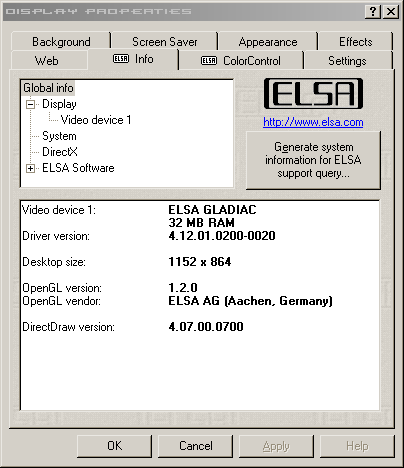 |
|
|
|
In the Forums... |
Posted: May 15, 2000 Written by: Tuan "Solace" Nguyen Cost: About $350 The Specs Here are the specs for the Gladiac: - NVIDIA GeForce 2 GTS GPU - 256-bit graphics engine - 200MHz core/166MHz memory clock (effectively 333MHz) - 25 million triangles/sec - 800 Mpixels/s fill rate - 1.6GTexels/sec fill rate - 5.3GB/sec Memory bandwidth - Hardware Anti-Aliasing - 32-bit colors, Z/stencil buffer - 350MHz RAMDAC - Max Resolution 2048x1536 - 32MB DDR RAM - VIVO (Video In/Out) module interface - AGP 2X/4X including fast writes and execute mode - DirectX texture compression - S3TC support - Windows 9x/NT/2000 compatible - 6 year warranty GTS: GigaTexel Shader GTS stands for "GigaTexel Shader". As the name suggests, some new features have been added to the GeForce 256, but we'll get to that later... What is a GigaTexel? It is one billion filtered textured pixels. But the GeForce 2 GTS's powerhouse doesn't stop there -- it delivers up to a full 1.6 billion texels/sec; more than three times that of the GeForce 256. But the speed increase isn't the only upgrade that the GeForce 256 received. The term "shader" should have indicated a new lighting feature as part of the T&L system. The shading engine enables per-pixel shading and lighting. NSR: NVIDIA Shading Rasterizer Likely one of the most significant feature for the GeForce 2 GTS is the inclusion of what NVIDIA calls the NVIDIA Shading Rasterizer or the NSR. What is the NSR? We can't tell you what it is, you just have to s-- okay, enough Matrix stuff. But as a matter of fact, it is a matrix. It is a one by seven matrix. The NSR is a radically new rendering engine. It can juggle 7 pixels in a single pass applying advanced per-pixel shading effects. What is per-pixel shading? It's a method of applying special rendering effects... per pixel. It allows material and real world effects to be applied individually to a pixel for more accuracy and intensity. Per-pixel shading will redefine the visual look and feel of imagery for PC graphics. Per-pixel shading has long been used in film production to create a more realistic and lifelike appearance for computer generated imagery. If you've seen Toy Story, you'll definitely remember Buzz Light-year. Remember the translucent reflection on Buzz's helmet? How the environment and light streaks reflected off the glass but also let the image underneath show through? That was done with per-pixel shading. Until now, it wasn't practical to use per-pixel shading on a PC because of the intense power and processing requirements needed. Sure, you could have done that in 3D Studio but could you have done it in real-time? Could the effect be applied to an entire frame at high resolution in 1/60th of a second? Not until now. Per-pixel shading is useful for simulating natural phenomena and accurate surface attributes such as fur, cloth, metals, glass, rock, and other highly detailed surfaces. Traditionally, effects were done on an entire triangle and sometimes an entire texture using a technique called interpolation. Special effects were done using calculations based on the vertices of the triangle and interpolating the entire area from the vertices. The end result is a generalized visual appearance… like an estimate or approximation of the final image. The benefit of using interpolation is it is fast to apply. But, the downside to it is that with large triangles, the resulting image contains artifacts, which degrades overall image accuracy and quality. Using per-pixel shading, effects and calculations are applied to individual pixels. Since the triangle will be composed of many pixels, the resulting image is highly accurate in representing what the image was intended to be. Let's assume that a generic triangle is drawn together (including its area) using 100 pixels. Now, we also have a effect pallet of 10 effects. Each pixel then, can accept any one of the ten that are available. That's an outcome of 10,000 different possible effects just for that one triangle. If interpolation was used, than the effect is fixed using that one out of ten effects and generalized across the entire triangle. Below is a visual comparison between interpolation and per-pixel shading. The action doesn't stop there. This entire section was assuming that one pixel was being manipulated in one pass. The GeForce 2 contains 4 pixel pipelines... enabling seven effects per pixel, per pipeline, per pass! These are the major features that nVIDIA has put into the GeForce 2 GTS chip. Want to know more in-depth information about it? Head over to our guide about the GeForce 2 GTS. Drivers The CD that came with the card included a slew of programs and drivers. There were versions for Win9x, Win2000, and WinNT4. Elsa also included nVIDIA's 5.16 Detonators. Let's talk about Elsa's own drivers though -- which I must say are really good. Elsa has included a few extra functions that are not available with nVIDIA's reference drivers.  Here you notice that Elsa has included an in-depth Info tab that tells you about the card you have, and versions of the drivers and DirectX files. Notice the "Video Device 1"? If you have another Elsa card inside your PC, you can view information about that one, too. |
||
|
| |||
|---|---|---|---|